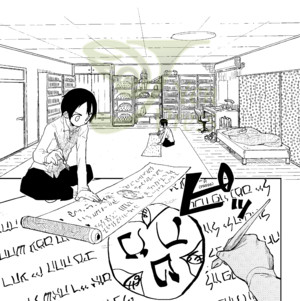The Spring 2025 Manga Guide
meth-e-meth
What's It About?

meth-e-meth has story and art by Kenji Tsurubuchi, with English translation by Ko Ransom, and lettering by Phil Christie. Published by Yen Press (March 11, 2025). Rated 16+.
Is It Worth Reading?
Lauren Orsini
Rating:

Is it me, or have art standards become increasingly stringent for professional manga artists? It used to be that you didn't have to have a photorealistic drawing style to make it big, so long as you had a compelling story. That's what makes meth-e-meth, a released manga compilation originally published in 2013, show its age the most. Its art style could be described as crude, even childish. Even its story elements, like an elite soldier in the body of a petite high school girl, who for some reason has to stay at the house of an ordinary boy, feel like relics of another time. But the story's unique take on Jewish mythology makes it worth a read.
In a world where autonomous bots called “autoscrolls” work as public servants for humans, Yuzuki is an average teen in his high school's Oath Club—a group of kids who enjoy constructing their own autoscrolls. Yuzuki is an “oath writer,” somebody who writes directive text in Esperanto to govern the autoscroll's behavior. Everything changes when Yuzuki finds a strange scroll with unrecognizable text (that most US readers will recognize as Hebrew). Now this ordinary boy is caught up in an ancient battle between the Disperanto and the Light Seekers, and believe it or not, you're supposed to assume the Light Seekers are the bad guys. An elite Disperanto autoscroll named Fragilo is assigned to monitor Yuzuki, made simpler by the fact that she is indiscernible from a regular high school girl. In between high school rom-com hijinks, Yuzuki falls deeper and deeper into the conflict. Could he be the messiah that both sides have been waiting for? Yeah, it's that kind of heavy-handed “ordinary kid saves the world” type of plot that has the author self-awarely writing “it does have its shortcomings” in the postscript.
The title meth-e-meth is a play on “emet” and “met,” the words for “truth” and “death” in Hebrew, which, according to Jewish folklore, can be used to activate or deactivate a golem. The story's take on one of the most interesting parts of Jewish mysticism makes for a fascinating concept, but there are flaws in both its execution and design. It's clear that the author is less familiar with Judaism than many English speakers will be from the first time a Hebrew scroll is shown and the text is mistakenly conveyed upside down. Even though this is likely the author's error, Yen Press ought to have had a note about it. The golems are super cool, but the standard plot of an ordinary boy turning out to be the One True Hero and standing up against the shadow organization that the girl-who-kicks-butt can't face is extremely last decade.
Kevin Cormack
Rating:

Golems are a fascinating aspect of Hebrew mythology, their presence dating back hundreds, if not thousands of years. Clay automatons animated by the power of ancient words, they appear in all kinds of modern fiction, often as ways for magicians to delegate physical or dirty work to disposable minions. The modern world in meth-e-meth is built upon the widespread use of golems in society, their manufacture codified and regulated. Human-shaped but built from a mix of synthetic nerve fibers and prosthetic limbs, they are controlled by inserted scrolls inscribed with magic writing. Modern golems run on Esperanto scrolls as opposed to ancient models controlled with Hebrew inscriptions.
The golems use the scrolls like a computer operating system, in that they contain a list of commands to do or not do certain things. They “serve the words, not the humans who wrote them,” so it's important they have commands not unlike Asimov's three laws of robotics inscribed on them. Protagonist Kyuuta Yuzuki is a member of his school's golem club – they design and build their own golems, writing control scrolls, and entering them in inter-school competitions. One night, something goes horribly wrong, and Kyuuta finds himself embroiled in a complex struggle between two rival factions battling over the scope and purpose of golem use in society. Thankfully, he's protected by golem/human hybrid Fragilo, a powerful girl with secrets and struggles of her own.
A story originally serialized over a decade ago, meth-e-meth's twelve chapters have now been collected into a single, complete volume. It's fun story, if quite rough around the edges, and sometimes a little hard to follow. The art is simple and scratchy, but mostly adequate, though some action sequences are confusing. It reads very much like a manga produced by an author transitioning from amateur to professional work. In fact, in his afterword, author Tsurubuchi admits that the work has flaws compared to his later manga.
If anything, the manga's vibe is very similar to last year's Mecha-Ude anime, and its accompanying manga. The relationship between Kyuuta and Fragilo is reminiscent of Mecha-Ude's central duo, and the story of two organisations trapped in an ideological battle while another race of automatons is caught in the middle is thematically almost identical.
meth-e-meth's strengths are in its fascinating world-building and attempts to integrate real world history with its outlandish technology. While the art is quite rudimentary, the golems themselves are quite cool, especially the more alien designs introduced later. It's a decent shonen action story, satisfactorily complete in one volume, though it does seem like it could have run much longer, had it been given the opportunity.
Disclosure: Kadokawa World Entertainment (KWE), a wholly owned subsidiary of Kadokawa Corporation, is the majority owner of Anime News Network, LLC. Yen Press, BookWalker Global, and J-Novel Club are subsidiaries of KWE.
discuss this in the forum (28 posts) |
this article has been modified since it was originally posted; see change history
back to The Spring 2025 Manga Guide
Seasonal homepage / archives